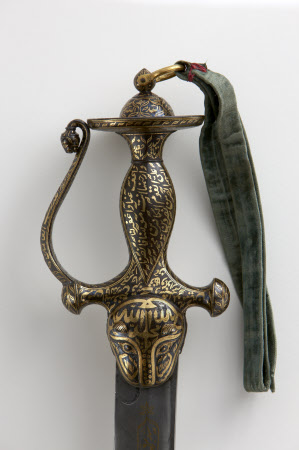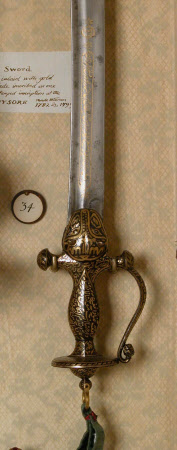Sword
Category
Arms and armour
Date
1782 - 1789
Materials
Steel and gold
Measurements
885 mm (L)
Place of origin
Mysuru (Mysore)
Order this imageCollection
Powis Castle and Garden, Powys
NT 1180590
Summary
Steel sword, made between 1782 and 1799 in Mysuru (formerly known as Mysore), India. The blued steel hilt is inlaid with gilt quotations from seven different surahs (chapters) of the Qur’an and one short prayer in Arabic. The hilt’s langets and terminal are modelled as tiger heads. The tiger-head langets are designed as a caligramme, repeating the names of God, Allah, the Prophet Muhammad, and Ali, cousin to the Prophet Muhammad. The single-edged steel blade is curved and has a shallow fuller and ricasso. It is inscribed on one face in gold and has a stamped inscription at the forte. The broad, curving blade suggests Turkish influence in its form and has a 'T' - shaped back. Two green velvet straps are attached to the swivel. This sword is associated with Tipu Sultan (1750-99), the ruler of Mysuru (formerly known as Mysore). Tipu Sultan succeeded his father as ruler of the South Indian state of Mysuru in 1782, where he built a sophisticated court around his palace at Srirangapatna (formerly known as Seringapatam). Tipu was a powerful ruler whose reign was characterised by military conflict and reform. During his 17-year reign, Tipu introduced direct revenue collection, changes to land ownership, investment in agriculture and industrialisation, and social reforms. He also supported the establishment of factories and trading companies beyond Mysuru and the immigration of skilled foreign workers in order to develop local capability to produce modern firearms [Satyanarayana, p. 2245-7]. Tipu associated himself with a tiger motif, a powerful emblem in pre-colonial India. Many items associated with Tipu bear representations of tigers and tiger stripes, including arms, coins, book bindings, and eight tiger-head finials from his throne [Brittlebank, p. 258-9]. One finial was acquired by Edward and Henrietta Clive after the sack of Srirangapatna in 1799 [NT 1180713]. The tiger-head langets on the hilt of this sword suggest that it came from Srirangapatna. The inscription of a Persian couplet, on the underside of the disc pommel and on the blade, names Haydar. This is a reference to Ali, cousin to the prophet Muhammad, who was nicknamed ‘Haydar’, which means ‘lion’ in Arabic, but also to Tipu's father, Hyder Ali. The surahs quoted from the Qur'an convey Islamic concepts of victory in war.
Full description
Research Note on Provenance Tipu Sultan spent much of his reign engaged in the defence of Mysuru against encroachment by the British East India Company. In 1798, a renewed British campaign provoked the Fourth Anglo-Mysore War. On 4th May 1799, during the Siege of Srirangapatna, Tipu was killed. In the immediate aftermath, the British army looted the town. According to Colonel Arthur Wellesley, later the Duke of Wellington, ‘Scarcely a house in the town was left unplundered, and I understand that in camp jewels of the greatest value, bars of gold etc etc have been offered for sale in the bazaars of the army by our soldiers, sepoys and followers. I came in to take command of the army on the morning of the 5th and with the greatest exertion, by hanging, flogging etc etc in the course of that day I restored order…’ [Dalrymple, p. 351]. The resumption of control by the higher ranks of the army enabled the work of the prize committee to begin. Prize committees were responsible for ‘collecting, inventorying and disposing of booty seized from the enemy and for … seeking to establish combatants’ entitlement to prize' [Finn, p.17]. They were intended to prevent the kind of undisciplined plunder which Wellesley reported in the aftermath of Tipu’s defeat at Srirangapatna. More than 1,000 commissioned officers took their allotted share in the captured property, which they kept, exchanged or sold to others. High value, or high-profile items, were excluded from the prize committee’s remit, and given to senior civil and military personnel, as well as the British royal family. Not all articles were genuine: tenuous or spurious attributions to Tipu Sultan have been identified in objects which were brought to Britain. Recent work on a sword at the Wallace Collection [OA1402] has shown that an inscription on the blade suggesting personal ownership by Tipu was added after his death in 1799. A letter to Edward Clive (1754-1839), then Governor of Madras (1798-1803), may refer to this sword, shedding light on how it reached Powis Castle. Allan Grant, a captain in one of the armies which besieged Srirangapatna, wrote on 30th November 1799: ‘Understanding from Genl. Floyd that Swords or Firelocks made in the Arsenal of this place & found in the Palace of the late Tippoo Sultaun, are consider'd curious, & much sought after at Madras. I have taken the liberty of sending to your Lordship by Lieutt. Sydenham a small assortment of these Articles, which appear to me of equal workmanship with any that have been found here.’ He notes: ‘I have alter'd the mounting of the Sword, as it would not have been possible for your Lordship to have worn it with the original Scabbard & I have preferr'd covering it with Green Velvet instead of Red to make it Correspond with the Facings worn by the Shropshire Militia in case your Lordship should at any time be disposed to bear it.’ [1] The scabbard associated with this sword, NT 1185192, appears to have been altered as described here, suggesting that this could be the sword referenced in Grant’s letter. As Colonel of the Shropshire Militia, Clive would have been mounted and the suspension rings now attached to the scabbard would have been essential to enable attachment to the standard pattern sword belt for mounted officers. [2] [1] British Library, IOR/L/MIL/5/159: Prize and Batta Rolls: Seringapatam 1799 (1800) [2] K Hazzard, personal communication, 25/2/22.
Provenance
Accepted by HM Treasury on 21st March, 1963 in lieu of tax and conveyed to National Trust ownership on 29th November 1963.
Marks and inscriptions
Hilt:: Seven quotations from the Qur’an, including: 'Victory comes from God' (LXI, 13) 'God is best as protection' (XII, 64) 'If you [those who believe in God] give victory to God [ by following His will in displaying their spiritual rectitude] He shall give you victory and make your progressions a firm one' (XLVII, 7). Almond-shaped cartouche containing part of an Arabic prayer, continued on other side: ‘Have pity on us, grant us forgiveness, have compassion for us, Thou art our Lord: give us victory over the people who have dis-believed...' Along the four lines of this Arabic prayer on one side are two invocations to Ali addressed as Haydar (the lion) and Safdar (the fighter). [FInformation from Archer et al. Treasures of India, p. 47] Langets: The tiger-head langets are designed as a caligramme. The outline of the face, including the nose and the two eyes, is defined by the stylization of the name Ali repeated twice. Over the forehead the name of God, Allah, is repeated twice with the name of the Prophet Muhammad, beneath. [From Treasures of India, p. 47] Inlaid on blade and on underside of disc pommel: Incised in Persian: Shud barq-i jān-i kāfarā[n] tīgh-i ẓafar buniyād-i man Sultān-i dīn Haydar buva[d] dar Fatḥᵉ bar imdād [?]-i man Translated: My blade that lays down the foundations of victory is the lightning that flashes through the lives of the infidels The sultan of faith Haydar relies in his conquests upon my help. [Transcription and translation from Treasures of India, p. 47] This inscription is also found on sword NT 1180589.
References
2019 Dalrymple: W Dalrymple, The Anarchy: The Relentless Rise of the East India Company, Bloomsbury 2019 2018 Finn: Margot Finn, ‘Material Turns in British History I: Loot’, Transactions of the Royal Historical Society, Vol. 28, December 2018 2004 Satyanarayana: A Satyanarayana ‘Review: The Mysore Sultans. State and Diplomacy under Tipu Sultan: Documents and Essays by Irfan Habib’ Economic and Political Weekly 39 24 (2004) 1995 Brittlebank: K Brittlebank, ‘Sakti and Barakat: The Power of Tipu’s Tiger. An Examination of the Tiger Emblem of Tipu Sultan of Mysore’, Modern Asian Studies 29 2 (1995) Archer, Rowell and Skelton 1987 Mildred Archer, Christopher Rowell, and Robert Skelton, Treasures from India: The Clive Collection at Powis Castle, London, 1987


